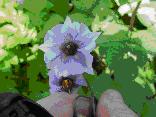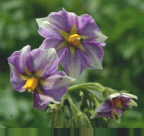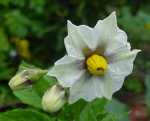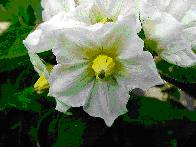
Potato Flowers
Lunden (1932) summarised the colour of potato flowers are follows:
There are two groups:
| COLOURED These are subdivided into: "reddish" and "bluish". Both of these can be very pale to very deep in colour. The tips of the petals may still be white. The colour is confined to the upper epidermis of the petals. | WHITE Salaman (1926) and Black (1930) reported that some of these possess a small amount of pigment, usually confined to the lower epidermis. |
A number of workers have found that white flowers are recessive to coloured. But sometimes white x white gives coloured forms.
Salaman suggested:
D, a basic gene, which, when alone, produces no colour.
R, a red gene, which only works if D is present.
P, a third gene, giving purple, which only works if R and D are present.
This would give:
PRD = purple
pRD = red
PRd = tinged white
other combinations = white
Salaman states that this is an oversimplification and that other genes must be involved. For example, Salad Blue has pure blue flowers...-N.D.
It now seems clear that pigmentation is governed by three main types of gene:
1. a basic gene.
2. a red-producing gene.
3. a blue-producing gene.
To this may be added an anthocyanin (plant pigment) inhibitor.
There is strong evidence for different but simiilar versions of the basic, red- producing and blue-producing genes, since one does not always get the expected result from crossing apparently identical material.
Pictures (click on small images for detail):

BLUE (Salad Blue) 
PURPLE (Catriona) | 
TINGED WHITE (Congo) 
WHITE (Epicure) |
Nigel Deacon / Diversity website